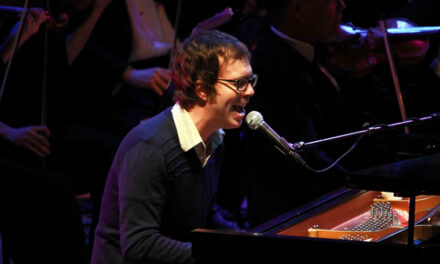With 27 members, the North Carolina Baroque Orchestra is not that much smaller than the Academy of St. Martin in the Fields, which recently had the temerity to release a CD pairing two of Beethoven’s symphonies. The gap in size seems to narrow when you subtract the modern horns and clarinets from the St. Martin outfit, but then you won’t find harpsichords or theorbos in a modern orchestra. Put the NC ensemble in a hall as pleasantly reverberant as the sanctuary of the Davidson College Presbyterian Church, and they sound downright commanding and robust. Their latest concert package, “A Musical Banquet,” is hardly hyperbole when you experience it, a generous spread of Bach, Vivaldi, Telemann, and Rameau.
Wielding long baroque trumpets, Jay Martin and Douglas Wilson got the concert off to a resounding start in Bach’s Orchestral Suite No. 3, S. 1063, abetted by Lance Pedigo’s thumping accompaniment on timpani. Conductor Frances Blaker didn’t seek any compromises from the strings in the pacing of the Ouverture, so the heraldry resounded joyfully through the hall. We could pay closer attention to the textures of the strings as the tempo downshifted for the familiar melody of the Air, ethereally transparent as the movement started, gaining a touch of grit as the piece gathered steam before subsiding into sweetness. Trumpets and timpani returned for the brief romp of the Bourée and then grew statelier and jauntier for the closing Gigue as Blaker pushed the tempo of the strings with heavier accenting.
Brass, timpani, and winds fluttered off into the front row pews for the tenth concerto of Vivaldi’s L’Estro armonico – and a noticeable chunk of the ensemble’s power departed with them. Nearly half of NC Baroque’s violin section was conscripted into solo roles in this Concerto for four violins, cello, and strings. Compared with my Europa Galante recording, with Fabio Biondi as both director and lead violin soloist, the “Banquet” version was short on heft and bravura. Yet there was no lack of Vivaldi’s unique baroque energy, particularly in the middle movement, which vividly reminded us of the composer’s programmatic gifts, with Blaker adroitly piloting the ensemble through a moody Largo-Larghetto-Adagio-Largo sequence of tempos.
Jean-Philippe Rameau has long been among a select group of composers whose work I feel to be most criminally neglected, so it was gratifying to hear Blaker express similar sentiments introducing a pupu platter of orchestral pieces culled from the Frenchman’s lush array of operatic works. Not very long ago Marc Minkowski collected 17 such pieces into an acclaimed CD, Une Symphonie Imaginaire, that he recorded with Les Musiciens du Louvre, so it’s probably not a coincidence that three of the four pieces that NC Baroque play can be found there. As the oboes and bassoon rejoined the ensemble, a trio of flutes was newly present. Nor were the flutes long in making their presence felt, sounding heavenly in the selections from Rameau’s posthumous Les Boréades, quite a soothing piece in a churchly setting. When it came time to quicken the pace and pour on the thunder, in the selections from Dardanus and Platée, the NC Baroque didn’t match the speed and power of the Louvre ensemble. But they made music more than pleasing enough to encourage listeners to further explore Rameau, and the double reeds over the strings achieved a brassy vibrancy that is very rare.
After intermission, we re-gathered around an E minor Ouverture from Georg Philipp Telemann’s Musique de Table, beginning with a very rich orchestral texture in its Lentement section, a pleasant reminder of the evening’s overarching banquet theme. In between the repeated slow sections, a sprightly Vite interlude was sandwiched in featuring some very effective playing from the three flutes. But after Blaker’s apologies for the placement of the soloists for Bach’s C minor Concerto for two harpsichords, S. 1062, the performance started off by confirming my misgivings in the opening Allegro, sounding as if the soloists were playing in an adjoining room – or Bach had actually written this concerto for two clavichords, far stealthier instruments. Wind players in front of the soloists seated themselves to facilitate the passage of sound to the audience, but they still conspired with the strings in both outer Allegro sections to reduce the keyboards to a whisper. In the middle Adagio movement, Jennifer Streeter and Beverly Biggs proved their mettle as the orchestra quieted down, and in the jaunty final Allegro we did have the consolation of the double reeds playing a brassy role once more. Hopefully, as this program continues its tour through Cary, Kinston, and Rocky Mount in the coming days, Streeter and Biggs will be accorded more advantageous placement for their instruments.
No such adjustments will be necessary when NC Baroque reaches their program finale, the Sinfonia from Bach’s Easter Oratorio, S 249. Martin and Wilson returned to their perch with their trumpets, a little shaky at the outset as they had been launching the Orchestral Suite but still sending wondrous jolts through the sanctuary. The abrupt shift to 3/4 tempo was thrilling, Pedigo’s timps adding an extra charge, and concertmaster David Wilson was steady and eloquent in his solos. Lovelier yet was the work of Meg Owen on a pair of swelling oboe solos that demanded impressive breath control. Owen’s concept of how the music should be phrased was occasionally surer than her actual articulation, but her intonation was flawless with a timbre that was noteworthy for its fullness.











